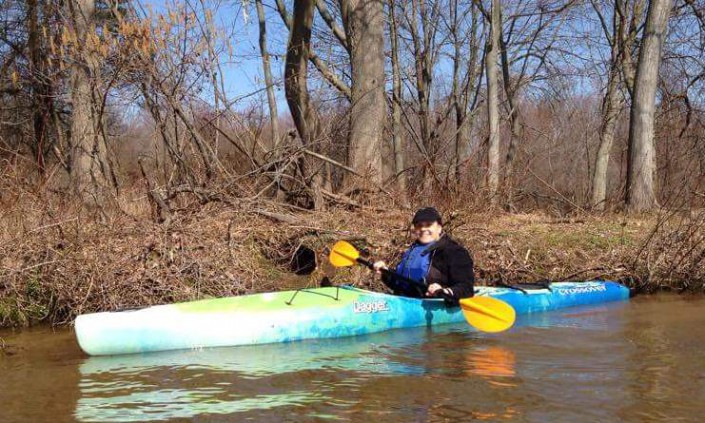Meet the 2015 Honorees: Tanya Oznowich, Women & Wildlife Education Award Winner
Ms. Oznowich Recognized for Championing Environmental Education in New Jersey for Over Three Decades
by Lindsay McNamara, Communications Manager

Schools across New Jersey are incorporating environmental education into their curriculum, a new movement inspired by a growing awareness of environmental issues and our shared role in understanding and resolving them. To a large degree, this growing prominence is thanks to Tanya Oznowich, Environmental Education Supervisor of the New Jersey Department of Environmental Protection, who has championed environmental education for over three decades.
Ms. Oznowich earned her Bachelor’s degree in Parks and Recreation/Interpretive Sciences from Slippery Rock University in 1981 and her Master’s in Educational Leadership from Delaware Valley College in 2004. She has been engaging the public in natural resources since 1979. Since beginning her tenure with the NJDEP in 1988, she has dedicated herself to integrating environmental science into New Jersey’s classrooms, from kindergarten to college.
In addition to her role as a program developer, Ms. Oznowich is also a workshop facilitator, public speaker, environmental educator, and a grant writer. For her accomplishments in bringing environmental education to so many classrooms and communities, she has been honored by numerous state and non-profit agencies, including the New Jersey Education Association, New Jersey Audubon Society, and the New Jersey Chapter of the Society for Women in Environmental Professions.
Join us to honor Tanya and the two other 2015 Women & Wildlife Award Winners on Wednesday, October 28 beginning at 6pm. Purchase events tickets and find more information.
We asked Tanya a few questions about what working in environmental education means to her:
Name one thing you can’t live without.
I cannot live without experiencing nature. To see and smell it, listen to it, explore it in different seasons, different types of weather and different times of day and night; to walk, drive, paddle, sit or sleep in it. It is soothing, intriguing and invigorating. In it I find my God and my truest self.
What do you find most challenging about your profession?
In social studies elementary students learn about home, community and responsibility. In science they learn about the basic needs of animals and plants and the life-sustaining connections that we have with water, air, shelter, energy and land; then, the depth and breadth of what students must know and be able to do swallow these up. We each have an intimate relationship with our surroundings – we each are part of the Earth’s natural systems. This is our common ground and it beckons us to act as “we” societies instead of “me” individuals. I am grateful that green practices and sustainability have entered our worlds of education, business, development and government; our relationship with Earth systems must be considered and understood in all we do.
What motivates you to get out of bed each morning and go to work?
I have always been driven by passion and commitment but this is now fueled by excitement. I believe that education about the environment is a necessity. Is it becoming more common in New Jersey schools? Yes! There are increasing examples of it to being woven into science, social studies, health, the arts – all subjects and all grades. Many schools offer specialized courses and utilize outdoor classrooms, gardens, stewardship and citizen science projects. We have growing programs for green schools, eco-schools, healthy schools, urban schools and sustainable schools. Colleges and universities are pursuing similar initiatives and sustainability programs for businesses, municipalities and faith-based organizations are on the rise; and, nature-based pursuits are doing battle with our uses of technology. Do we still have barriers, challenges and needs to confront? Yes; but our environmental education efforts are taking hold and producing results, and the push for sustainability is strong.
Number one piece of advice you would give to someone who wants to change the world.
Embrace the value of what you believe in, determine a course of action, and then begin; as Nike says, “Just Do It.”
What interests you the most about New Jersey wildlife?
Watching wildlife fascinates me and I love to sit still and quiet in nature to wait, watch and listen for the wildlife that eventually creeps, crawls, flies or swims by me. I love to look under rocks and logs and collect bugs from streams; to examine nests and tracks and turn over the soil to see what moves. What interests me most about wildlife is that wildlife captivates people of all ages. For many of us, they are the ambassadors to nature. I admire and appreciate the work of New Jersey’s wildlife experts who have the passion and commitment to study, protect and manage our diverse wildlife populations.
Please join us on Wednesday, October 28, 2015, from 6:00 – 9:00 p.m. at Duke Farms in Hillsborough, New Jersey to honor the contributions that Tanya Oznowich, Pat Hamilton, and MacKenzie Hall have made to wildlife in New Jersey.
This year’s very special event will feature keynote speaker Governor Christine Todd Whitman. The event will also celebrate CWF’s past decade of honoring women for their success in protecting, managing, restoring, and raising awareness for the Garden State’s endangered and threatened wildlife species.
Learn more:
Lindsay McNamara is the Communications Manager for Conserve Wildlife Foundation of New Jersey.
